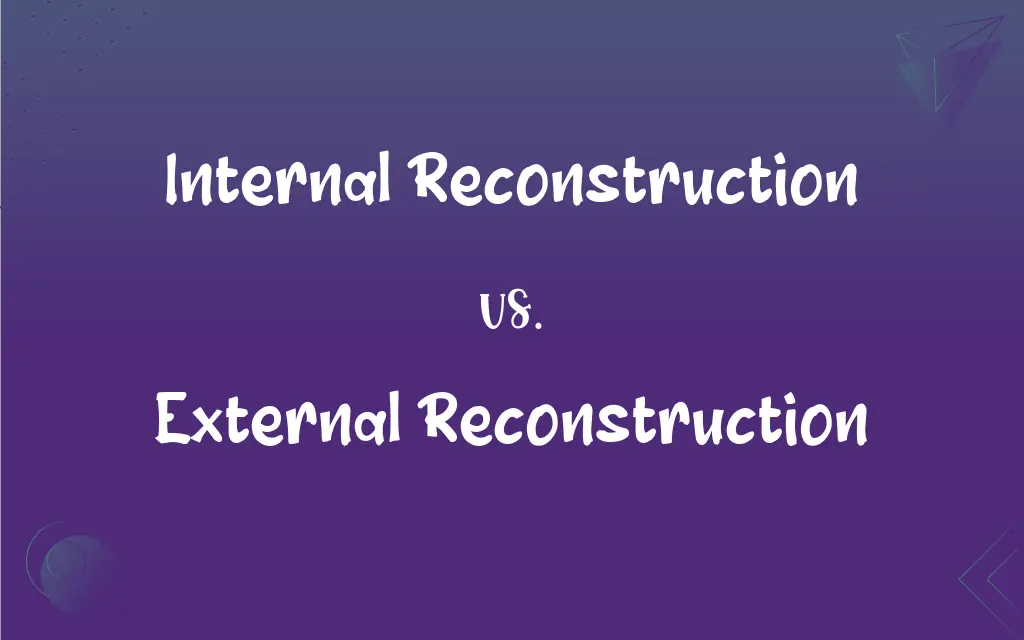Internal Reconstruction vs. External Reconstruction: What's the Difference?
Edited by Aimie Carlson || By Janet White || Published on February 26, 2024
Internal reconstruction involves reorganizing a company's capital structure internally, while external reconstruction involves forming a new company to take over the existing one.

Key Differences
Internal reconstruction is a process where a company restructures its financial and operational aspects without forming a new entity. External reconstruction typically involves creating a new company that then takes over the assets and liabilities of the existing company.
In internal reconstruction, the existing company's identity and legal entity remain the same, but changes are made to aspects like capital structure, debt reduction, and operational adjustments. In external reconstruction, the original company is usually dissolved, and a new legal entity is formed to continue the business.
Internal reconstruction often involves internal revaluation of assets, reduction of liabilities, and alteration of the share capital. External reconstruction, on the other hand, may include the transfer of assets and liabilities to the new company, and the issuance of shares of the new company to the shareholders of the old company.
The purpose of internal reconstruction is often to streamline operations and improve financial stability without the legal complexities of forming a new entity. External reconstruction is usually undertaken when more significant restructuring is needed, which might be beyond the scope of internal adjustments.
Shareholders' stake in the company may be affected differently in each approach. In internal reconstruction, shareholders retain their interest in the same company, though the value may change. In external reconstruction, shareholders may receive shares in the new company, potentially altering their stake and investment value.
ADVERTISEMENT
Comparison Chart
Formation of New Entity
No new entity formed
Involves forming a new company
Company Identity
Retains original identity and legal entity
Original company usually dissolved
Nature of Changes
Revaluation of assets, debt reduction
Transfer of assets and liabilities to new entity
Shareholder Impact
Shareholders retain interest in same company
Shareholders may receive shares in new company
Legal and Operational Complexity
Less complex, internally managed
More complex, involves legal formation of new entity
ADVERTISEMENT
Internal Reconstruction and External Reconstruction Definitions
Internal Reconstruction
Aimed at improving financial stability without forming a new entity.
The internal reconstruction streamlined their operations significantly.
External Reconstruction
Involves forming a new company to take over the existing one.
External reconstruction was chosen, leading to the creation of a new entity.
Internal Reconstruction
Retains the company's original legal identity.
Despite internal reconstruction, the company kept its original name and legal status.
External Reconstruction
More complex involving legal formation of a new entity.
The legal complexities of external reconstruction were managed by a team of experts.
Internal Reconstruction
Restructuring a company's finances and operations internally.
The company underwent internal reconstruction to reduce its debt.
External Reconstruction
Shareholders may receive shares in the new company.
Shareholders were issued shares in the new company as a part of external reconstruction.
Internal Reconstruction
Involves revaluation of assets and alteration of capital structure.
Internal reconstruction led to a decrease in the company's share capital.
External Reconstruction
The original company is usually dissolved.
Post-external reconstruction, the original company was legally dissolved.
Internal Reconstruction
Shareholders retain their interest in the same company.
Shareholders' stakes were adjusted during the internal reconstruction but remained in the same entity.
External Reconstruction
Transfer of assets and liabilities to the new company.
All assets and liabilities were transferred to the newly formed company.
FAQs
Does internal reconstruction affect the company’s legal status?
No, the legal status remains unchanged in internal reconstruction.
What is internal reconstruction?
It's the process of reorganizing a company's internal structure and finances without forming a new company.
What are common reasons for internal reconstruction?
Debt reduction, operational efficiency, and financial restructuring.
What defines external reconstruction?
It involves creating a new company to continue the business of an existing one.
Are creditors affected in external reconstruction?
Yes, as the debt and liabilities are transferred to the new entity.
What legal processes are involved in external reconstruction?
It involves legal procedures for forming a new company and dissolving the old one.
Are shareholders affected in external reconstruction?
Yes, they may receive shares in the new company, altering their stake.
Can internal reconstruction help avoid bankruptcy?
Yes, it's often used to improve financial health and avoid insolvency.
Is external reconstruction a solution for severe financial distress?
Yes, it's used when significant restructuring is required.
Does internal reconstruction affect company culture?
It can, as internal changes might impact the work environment.
Does internal reconstruction involve new share issuance?
It can involve altering the existing share structure, but not necessarily new issuance.
How are assets valued in external reconstruction?
They are typically revalued and transferred to the new entity.
How is external reconstruction executed?
By legally forming a new entity and transferring assets and liabilities to it.
What happens to the original company in external reconstruction?
It's usually dissolved after the transfer of assets and liabilities.
Who decides on internal reconstruction?
Typically, the company's board of directors and shareholders.
How does internal reconstruction impact employees?
It can lead to changes in operations, potentially affecting employment.
What is the role of auditors in internal reconstruction?
They review and verify the financial restructuring process.
Can a failing company choose external reconstruction?
Yes, especially if it needs a fresh start with a new legal entity.
Is internal reconstruction quicker than external?
Generally, yes, as it involves fewer legal complexities.
What are the tax implications of external reconstruction?
There can be significant tax implications, requiring careful planning.
About Author
Written by
Janet WhiteJanet White has been an esteemed writer and blogger for Difference Wiki. Holding a Master's degree in Science and Medical Journalism from the prestigious Boston University, she has consistently demonstrated her expertise and passion for her field. When she's not immersed in her work, Janet relishes her time exercising, delving into a good book, and cherishing moments with friends and family.
Edited by
Aimie CarlsonAimie Carlson, holding a master's degree in English literature, is a fervent English language enthusiast. She lends her writing talents to Difference Wiki, a prominent website that specializes in comparisons, offering readers insightful analyses that both captivate and inform.
































































